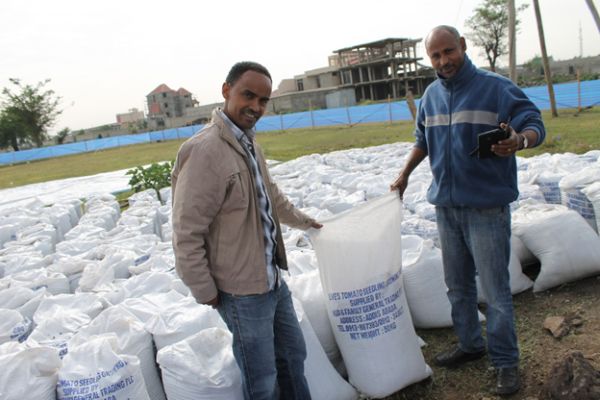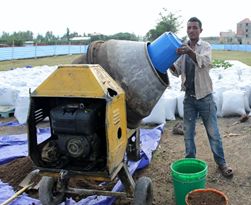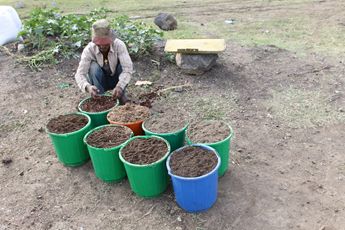Locally produced compost bags could help market gardeners
By Desalegne Tadesse
The Rift Valley region of Ethiopia in general, and Eastern Shoa in particular, has huge potential for irrigation development. It could become a major producer of high value crops such as tomatoes, onions, peppers and many other vegetables. Not only would this benefit farmers, but it also makes efficient use of limited water resources, delivering high yields from relatively modest inputs. Increasingly common in this context is the use of hybrid crop varieties such as the Galilea tomato. It is more resistant to disease and pests compared to conventional varieties and still delivers a healthy crop.

Nevertheless, supply of quality seedlings remains problematic, and has been identified by the Livestock and Irrigation Value Chain for Ethiopian Smallholders (LIVES) project, lead by the International Livestock Research Institute (ILRI) and International Water management Institute (IWMI), as a critical gap in agricultural development.
Until recently, international flower companies, which have large commercial operations in Ethiopia, delivered high quality hybrid tomato seedlings to the smallholders in Eastern Shoa and other parts of the country. The companies imported a seedling growing medium known as peat moss from Europe to produce the young plants. Unfortunately, a dispute arose between the Ethiopian government and the European Union on the use of Ethylene Oxide (EtO) to disinfect and sterilize peat moss. Under Ethiopian regulations, producers are required to use EtO, while in the EU this not permitted. As a result, companies ceased both the production of seedling growing media and supplying the seedlings.

So LIVES researchers decided to explore alternative solutions. After testing many possible combinations they finally came up with the LIVES Tomato Seedling Growing Medium. They then worked with a local company, KDG & Family General Trading, to supply the new product.
“As a result of the shortage, we were already on the look-out for alternatives,” says Kassa Getu, the general manager of KDG. “I chanced upon the LIVES research online and that laid the foundation for commercializing the new seedling growing medium”
The company’s 19 employees have now produced the first batch of 400-quintals (40,000kg) from its blending sites in Debrezeit, around 50km from Addis Ababa.
“At the moment, I am targeting big farms,” says Kassa. “We also supply tissue culture laboratories who are currently using European peat moss and coconut from India and West Africa. Step-by-step will reach out to smallholders”.
LIVES hopes to accelerate this process and is actively exploring how to spread the benefits to smaller producers.

LIVES scientists have compared seedlings grown on imported peat moss with those grown in the new medium to ensure that it is a cost effective and productive substitute. The new medium is composed of four components: 50% compost, 25% local peat soil, 12.5% sugar cane bagasse, and the remaining 12.5% is red ash. There is now strong evidence to suggest that the new compound can make a major contribution to the delivery of profitable, environmentally friendly, water efficient nutritious tomatoes which will boost the food and financial security of small-holders. The team are hoping to further improve the product over the coming months so that it can contribute to the government’s growth and transformation plan for irrigated commodities.
Further contacts: Amare Haileslassie (IWMI) A.Haileslassie@cgiar.org, Amenti Chali (ILRI) A.Chali@cgiar.org and Desalegne Tadesse, (IWMI) D.Tadesse@cgiar.org

